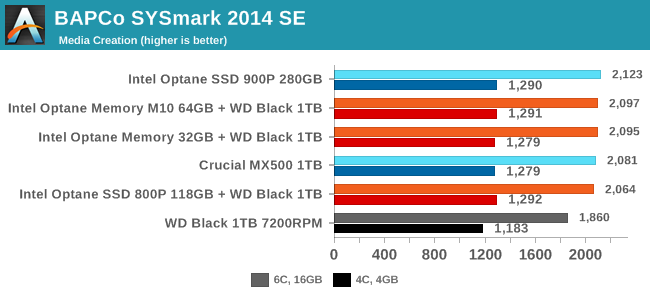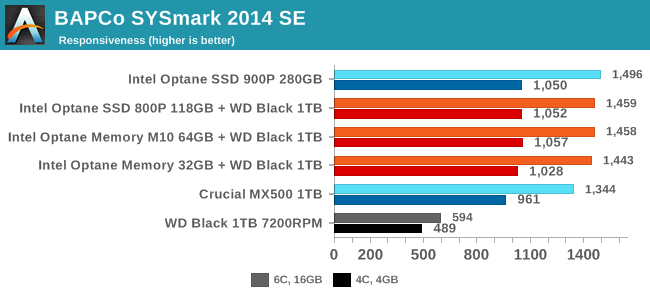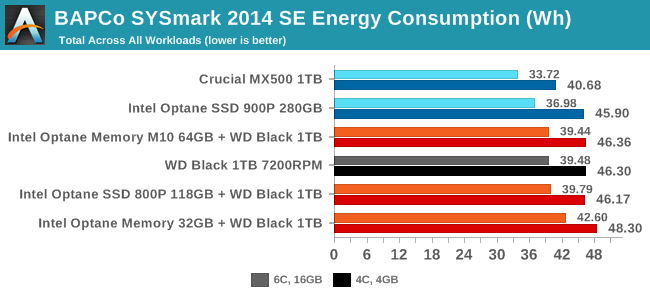The Intel Optane Memory M10 (64GB) Review: Optane Caching Refreshed
by Billy Tallis on May 15, 2018 10:45 AM EST- Posted in
- SSDs
- Storage
- Intel
- PCIe SSD
- SSD Caching
- M.2
- NVMe
- Optane
- Optane Memory
BAPCo SYSmark 2014 SE
BAPCo's SYSmark 2014 SE is an application-based benchmark that uses real-world applications to replay usage patterns of business users in the areas of office productivity, media creation and data/financial analysis. In addition, it also addresses the responsiveness aspect which deals with user experience as related to application and file launches, multi-tasking etc. Scores are calibrated against a reference system that is defined to score 1000 in each of the scenarios. A score of, say, 2000, would imply that the system under test is twice as fast as the reference system.
SYSmark scores are based on total application response time as seen by the user, including not only storage latency but time spent by the processor. This means there's a limit to how much a storage improvement could possibly increase scores, because the SSD is only in use for a small fraction of the total test duration. This is a significant difference from our ATSB tests where only the storage portion of the workload is replicated and disk idle times are cut short to a maximum of 25ms.
For this review, SYSmark has been used on two different machines: a relatively high-end system with a six-core Intel Core i7-8700K processor and 16GB of RAM, and a more limited system with a quad-core Intel Core i5-7400 processor and just 4GB of RAM. The low-end system spends a lot of time swapping thanks to its small amount of RAM, and this adds greatly to the storage workload.
| AnandTech SYSmark SSD Testbed | |
| CPU | Intel Core i7-8700K |
| Motherboard | Gigabyte Aorus H370 Gaming 3 WiFi |
| Chipset | Intel H370 |
| Memory | 2x 8GB Kingston DDR4-2666 |
| Case | In Win C583 |
| Power Supply | Cooler Master G550M |
| OS | Windows 10 64-bit, version 1709 |
| AnandTech SYSmark SSD Low-End Testbed | |
| CPU | Intel Core i5-7400 |
| Motherboard | ASUS PRIME Z270-A |
| Chipset | Intel Z270 |
| Memory | 1x 4GB Corsair DDR4-2666 |
| Case | In Win C583 |
| Power Supply | Cooler Master G550M |
| OS | Windows 10 64-bit, version 1709 |
None of the Optane Memory modules are large enough to serve as a Windows boot drive alone as well as storing all the applications used for SYSmark, so this section only tests the Optane Memory and Optane SSD 800P as cache drives. (The 118GB Optane SSD 800P is pretty much the smallest drive that can could run SYSmark, but it doesn't leave much room for user data.)



The Data/Financial Analysis, Media Creation, and Office Productivity sub-tests are all relatively insensitive to storage performance, and they are shown in order of decreasing sensitivity to the CPU and RAM differences between the two test systems. These results show that a mechanical hard drive can hold back application performance, but almost any solid state storage system—including Optane Memory caching—is sufficient to shift the bottlenecks over to compute and memory.

The Responsiveness test is less focused on overall computational throughput and more on those annoying delays that make a computer feel slow: application launching, opening and saving files, and a variety of multitasking scenarios. Here, moving off a mechanical hard drive is by far the best upgrade that can be made to improve system performance. Going beyond a mainstream SATA SSD provides diminishing returns, but there is a measurable difference between the SATA SSD and the fastest Optane SSD.
Energy Usage
The SYSmark energy usage scores measure total system power consumption, excluding the display. Our SYSmark test system idles at around 26 W and peaks at over 60 W measured at the wall during the benchmark run. SATA SSDs seldom exceed 5 W and idle at a fraction of a watt, and the SSDs spend most of the test idle. This means the energy usage scores will inevitably be very close. A typical notebook system will tend to be better optimized for power efficiency than this desktop system, so the SSD would account for a much larger portion of the total and the score difference between SSDs would be more noticeable.

The Intel Optane SSD 900P is quite power-hungry by SSD standards, but running a hard drive is even worse. The Optane Memory M10 and 118GB 800P further add to power consumption when used as cache devices, but they speed up the test enough that total energy usage is not significantly affected. The 32GB Optane Memory doesn't offer as much of a performance boost, and it lacks the power management capabilities of the more recent Optane M.2 drives.










96 Comments
View All Comments
Billy Tallis - Tuesday, May 15, 2018 - link
Yes, but since my AMD system is a Threadripper, it won't actually represent any cost savings compared to the systems tested in this review.evernessince - Wednesday, May 16, 2018 - link
AdoredTV already did a video showing the performance improvements from StoreMi.https://www.youtube.com/watch?v=D3-SqJHYzC0
AMD's solution works in the same way, in that as you run programs it stores data to the cache drive. The big difference is AMD's solution let's you use any SSD as a cache drive. This means it can be any size and it doesn't require an addition purpose. This is especially important, give the huge price tag of the larger optane drives.
Speed wise though, assuming the Intel SSD is actually big enough to cache all your data, they are about equal. Of course, the AMD solution would be slower if you used a really low end SSD as your cache drive. It could also be much faster if you used a really good SSD though. The Intel optane drive has performance numbers similar to a 960 evo. The problem for Intel though are the small sizes and large prices. $200 for only 118GB of space is not a good solution. You could get double that space with a brand new 250GB 960 evo and it costs half as much. That's assuming you want to keep that drive for caching only, you could simply use your current SSD with the AMD solution and save $200+ altogether.
I simply don't see a universe where Optane makes sense.
CheapSushi - Wednesday, May 16, 2018 - link
You realize you can use Optane like any other SSD right? You can even use it with StorageMI.MDD1963 - Tuesday, May 15, 2018 - link
There will be no tiny Optane things inserted into/wasting an M.2 NVME slot making it SEEM like I have a 960/970; there will be a 960/970. :)Valantar - Tuesday, May 15, 2018 - link
Any chance you could test one of these drives with AMD's new caching solution? AFAIK the drives show up as regular NVME devices, so it should work in theory. Would be really interesting to see these solutions compared, and if Ryzen or Threadripper can make proper use of Optane caching through third-party software.Billy Tallis - Tuesday, May 15, 2018 - link
I'll be setting up a Threadripper system this week to test both caching and NVMe RAID.Lolimaster - Tuesday, May 15, 2018 - link
My only use for an optane drive would be for swap file, firefox/chrome cache/install/profiles and GTA5.But a 500GB 860EVO cost $169 with 300TB of endurance vs 365TB on optane, with the 860 offering 4x the storage... dunno.
Their "low end" 118GB 800p needs to improve endurance to at least 1PB level to be a proper swapfile/browser/cache tool
evernessince - Wednesday, May 16, 2018 - link
So what's the point of this when AMD is giving away StoreMi with it's X470 boards? From what I've seen from reviews of the product, it works exceptionally well. It also doesn't require you to buy another drive and it can use much larger SSDs as a cache.CheapSushi - Wednesday, May 16, 2018 - link
You can definitely ignore Intel's marketing pitch about these. But you can use ANY Optane drive, including ones mentioned here like ANY OTHER SSD out there. So you can make it work with StoreMi too. You have to decide which drive benefits your workload more and how and what your budget is. Optane has inherent benefits that beats out NAND is many ways. But again, just depends on what you want. The smaller GB ones are pretty damn cheap in my opinion. So worth just trying out.Svend Tveskæg - Wednesday, May 16, 2018 - link
Reminds me of back in the days, when you could buy a weird plastic screen, that claimed it would turn your black and white television into a color-TV....